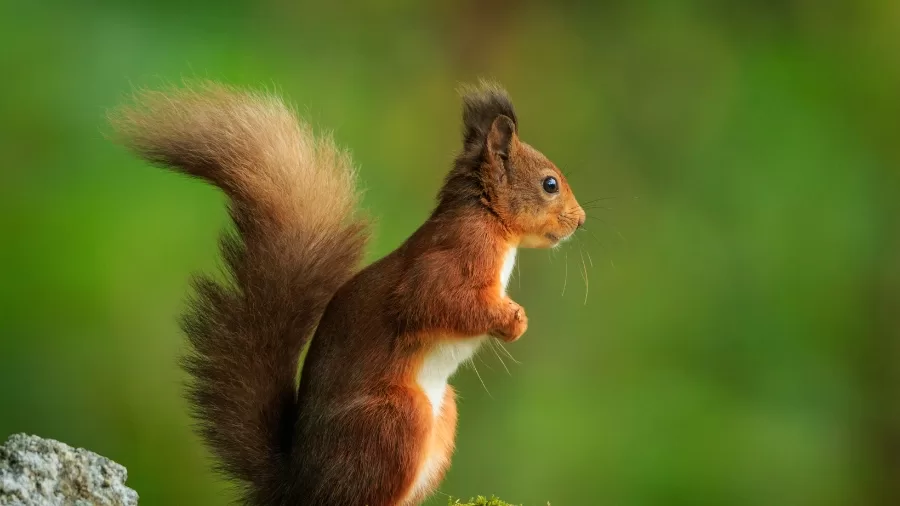Science & Environment
Red Squirrel Survival: AI’s Role in Protecting Britain’s Iconic Species

- Squirrel Agent, developed by Genysys Engine, is an AI technology designed to protect red squirrels by identifying species and automating food distribution and contraceptive management.
- Currently being tested in the UK, the system offers a more efficient, scalable approach to red squirrel conservation by reducing the reliance on human intervention.
- Beyond squirrels, AI holds vast potential for conservation, with uses extending to wildlife monitoring, detecting criminal activity, and predicting the effects of climate change.
Once abundant in Britain’s woodlands, red squirrels are now facing the brink of extinction. Their struggle for food and habitat has been exacerbated by the invasion of the larger, more aggressive grey squirrels, leaving red squirrels in small, isolated groups. Amidst this dire situation, a new ally has emerged to aid their survival: artificial intelligence (AI).
The Squirrel Agent: Revolutionising Red Squirrel Conservation
Enter Squirrel Agent, an innovative AI tool developed by Genysys Engine, poised to transform red squirrel conservation efforts. Leveraging training on hundreds of images, this advanced system can identify red and grey squirrels with an impressive 97% accuracy. It autonomously manages feeders to ensure red squirrels receive food while redirecting grey squirrels to feeders containing contraceptive paste, effectively controlling their population growth.
Currently being trialled across several UK sites in partnership with wildlife organisations, this approach promises to reduce reliance on human intervention and boost the efficiency of red squirrel conservation efforts.
Why Are Red Squirrels in Trouble?
The red squirrel population in the United Kingdom has seen a dramatic decline, primarily due to the introduction of grey squirrels from North America in the 19th century. Grey squirrels outcompete red squirrels for food and carry squirrel pox, a disease that is deadly to red squirrels but harmless to greys. This combination of competition and disease has pushed red squirrels into isolated habitats in Scotland, Ireland, and a few select islands, leaving their populations on mainland England and Wales severely diminished.
While traditional conservation efforts such as habitat restoration and population monitoring have been implemented, these methods are often labour-intensive and insufficient to address the scale of the problem. Artificial intelligence is now offering a groundbreaking alternative to help protect this iconic species.
AI: A Powerful Tool for Conservation
Artificial intelligence is transforming wildlife conservation with its ability to process vast amounts of data and make complex decisions. The Squirrel Agent system exemplifies how AI can enhance conservation efforts. By automatically identifying squirrel species and managing feeding stations, it not only reduces the need for human intervention but also optimises conservation outcomes. Red squirrels receive targeted feeding support, boosting their chances of survival, while grey squirrels are directed to feeders with contraceptive paste to control their population growth.
The potential of Squirrel Agent goes beyond species identification. Using technology akin to human fingerprint recognition, it can identify individual squirrels based on their unique whisker patterns. This breakthrough allows conservationists to monitor specific animals and their families over time, offering invaluable insights into population dynamics and behaviours. This level of precision heralds a new era in wildlife conservation, combining advanced technology with ecological stewardship.
Beyond Squirrels: AI’s Expanding Role in Conservation
The Squirrel Agent is just one illustration of artificial intelligence’s growing influence on conservation. Across the globe, AI is transforming how we monitor, protect, and understand wildlife and ecosystems.
- Wildlife Monitoring and Data Analysis: AI systems are revolutionising the analysis of camera trap data by quickly identifying species, tracking animal movements, and estimating populations. This allows researchers to gather insights at a scale and speed previously unattainable.
- Combatting Illegal Activities: AI is being employed to detect and prevent poaching through predictive modelling and real-time alerts. By analysing patterns in wildlife activity and human presence, these systems can identify potential risks and notify conservation teams.
- Climate Change Predictions: AI’s ability to process vast datasets, such as climatic trends and species distribution, helps prioritise conservation efforts. It can forecast how changing environmental conditions will impact habitats, enabling proactive strategies to protect vulnerable species.
Real-World Examples:
- The World Wildlife Fund (WWF) used AI to process millions of images in Australia, pinpointing areas where animals survived devastating bushfires. This information was crucial in directing recovery and habitat restoration efforts.
- Hobbyist Contributions: Everyday citizens are also leveraging AI, such as using innovative tools to deter wildlife from entering gardens. This demonstrates AI’s versatility in bridging professional conservation and grassroots efforts.
As AI continues to evolve, its applications in conservation will only expand, empowering experts and individuals alike to play a role in safeguarding our planet’s biodiversity.
Ethical Concerns and Challenges
While artificial intelligence offers significant advantages in conservation, it is not without challenges and ethical dilemmas.
- Algorithmic Bias: One of the primary concerns is the potential for bias within AI systems. If these systems are trained on incomplete or unrepresentative datasets, their conclusions can be flawed or discriminatory. For instance, a biased dataset might overlook certain species or fail to identify them accurately, undermining conservation goals. Addressing this requires continuous auditing and refinement to ensure AI operates fairly and inclusively.
- The Need for Oversight: As AI tools become more embedded in conservation strategies, ongoing evaluation is crucial. Regular reviews and updates are essential to enhance accuracy, improve efficiency, and ensure systems remain effective as environmental conditions evolve.
- Balancing Human Oversight with Automation: While automation reduces the need for human intervention, it also raises concerns about over-reliance. Conservationists must maintain a balance, using AI to complement rather than replace expert judgement and fieldwork.
- Privacy and Data Ethics: In conservation, especially when monitoring human-wildlife interactions or preventing poaching, ethical considerations about data collection and privacy arise. It’s essential to ensure that technology respects both human and environmental boundaries.
AI’s role in conservation holds immense promise, but ethical stewardship and rigorous oversight are vital in navigating these challenges responsibly.
A New Era for Conservation: Humans and AI Collaborate
The integration of human expertise and artificial intelligence marks the beginning of a transformative era in conservation. By uniting human insight with AI’s capacity to collect and process vast amounts of data, we are unlocking new possibilities to protect endangered species like the red squirrel. As technology progresses, it offers the potential to revolutionise conservation strategies—enabling us to monitor ecosystems more effectively, anticipate threats, and safeguard biodiversity for future generations.
AI has emerged as a powerful ally in the fight to preserve red squirrels and other endangered wildlife. The success of the Squirrel Agent exemplifies how AI can address pressing environmental challenges, showcasing the positive impact technology can have when harnessed for the greater good. From automated species identification to innovative population management, AI is reshaping how we approach conservation.
By embracing the power of AI, we can make significant strides toward ensuring a thriving future for red squirrels and the ecosystems they inhabit. As we advance, fostering collaboration between conservationists and technology will be vital for preserving the natural world and all its biodiversity. This partnership heralds a hopeful path forward in the shared mission to protect our planet.

























































